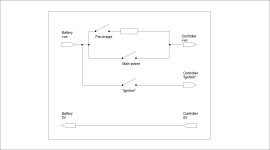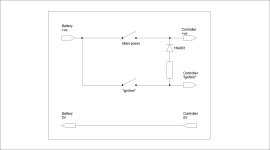The problem here is that people may be fitting the pre-charge resistor in the wrong place. If you're going to use this method of reducing the connection spark, then it's very important that you DO NOT connect the pre-charge resistor so that it feeds the controller "ignition" wire. You MUST only use the pre-charge resistor in-line with the main power feed to the capacitors and FETs.
The reasons are two fold:
- Firstly there is a risk of controller damage if you feed the ignition wire through another dropper resistor, as it may mean that the FET driver power regulator drops out of regulation, meaning that the 5V rail may also drop and you could possibly get some odd conditions, with FETs partially turned on in the output stage. This probably wouldn't cause damage, but it might, so it is better not to take the risk.
- Secondly, and perhaps more importantly, the controller will try and draw the "ignition" current through the pre-charge resistor if it's wired in the wrong place. This means that the pre-charge resistor cannot ever charge the capacitors to the full supply voltage, so you will still get a spark when you make the connection, unless you reduce the pre-charge resistor to a low value. This ignition current flowing through the pre-charge resistor will also make it get hot. Normally the pre-charge resistor won't see anything like enough dissipation to get hot.
Below are two possible ways to wire up pre-charge without accidentally powering the "ignition" feed via the pre-charge resistor. The first uses a separate pre-charge switch (or connector) and "ignition" switch, the second combines two functions and uses the "ignition" switch as the pre-charge switch. For the second option you switch the "ignition" on, then a second or so later switch the main power on. The diode stops the possibility of the main power feeding the "ignition" via the pre-charge resistor if they are accidentally switched in the wrong order.


In my view, it's actually better to get rid of the whole pre-charge thing and just use a slow electronic switch, as detailed elsewhere. That way you can have a simple, low current, on/off switch anywhere on the bike and use it to turn on and off the power with no worries about sparks etc.




